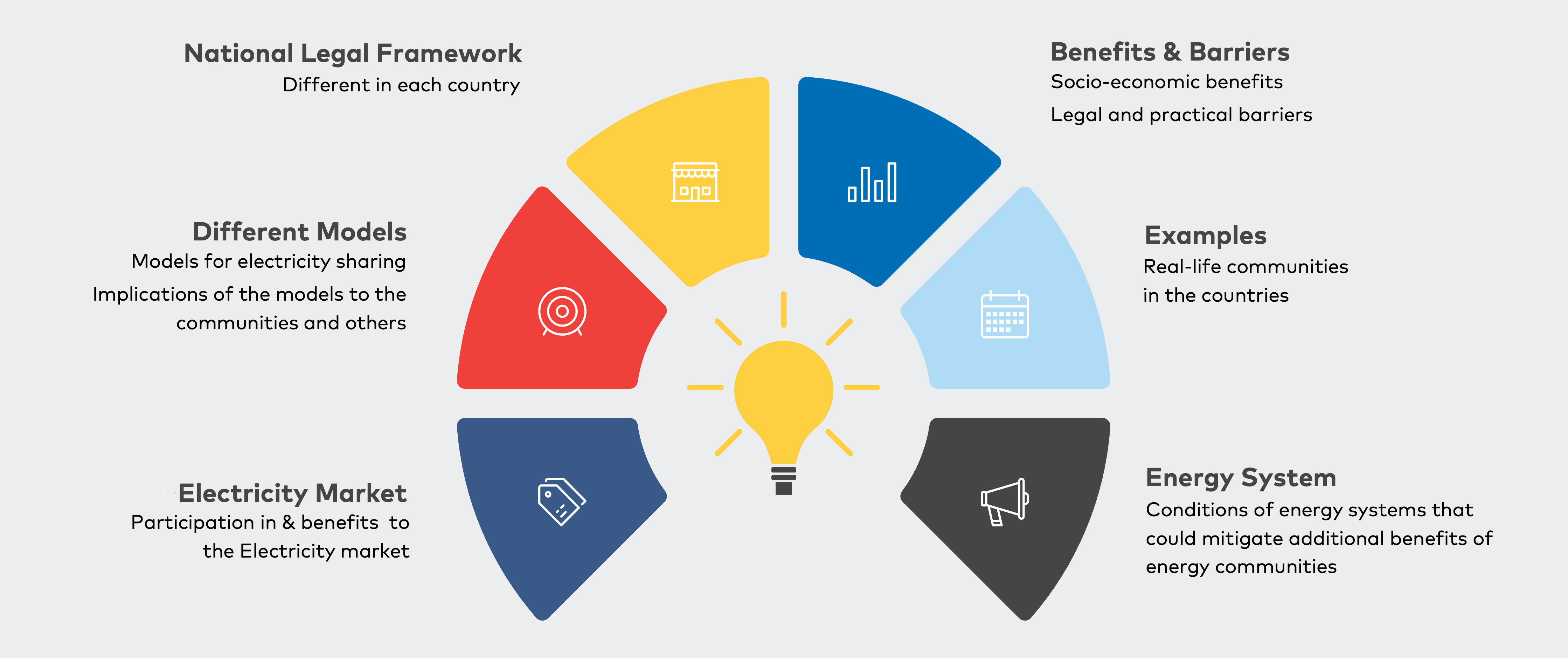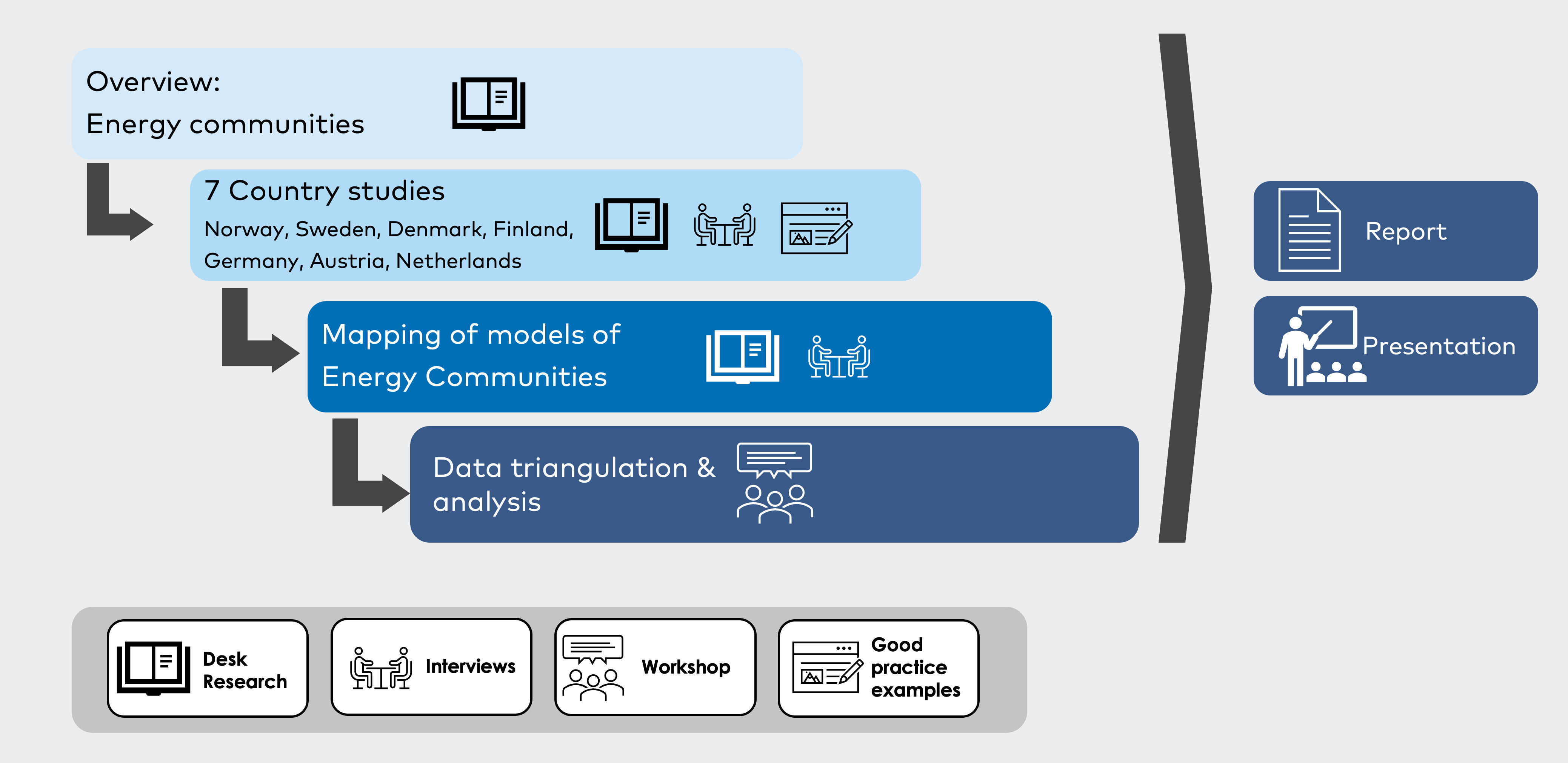↑ Photos: i Stock and Pixabay
2. Introduction
2.1. Purpose of Study
The Nordic countries are all looking for ways to enable a green transition, and a part of this is the electricity grids. The Clean Energy for all Europeans Package (CEP) released by the European Commission in 2019 put citizens in the middle of the energy transition. Through Article 16 of the Electricity Market Directive (2019/944; “Electricity Directive”) the new concept Citizen Energy Communities (CEC) was established and through the recast of the Renewable Energy Directive (REDII) the concept of Renewable Energy Community (REC) was established. The core objectives of the introduction of CEC and REC were to further the development of distributed energy technologies and to strengthen consumer participation in the energy markets, whilst prioritising the local production of electricity from renewable energy sources (RES). CECs allow for active consumer participation, either by generating, consuming, sharing or selling electricity, by providing flexibility services through demand-response and storage as well as – if member states have chosen this option – by operating the required electricity grid under the applicable requirements of the Electricity Directive for distribution system operators (DSOs).
In relation to what was outlined above, this study sets out to analyse how Energy Communities are currently implemented in Norway, Sweden, Finland and Denmark, and furthermore looks into similar models in three other European countries. In relation to Energy Communities, Nordic Energy Research (NER) also wants to investigate questions linked to market access, grid ownership and operation, and tariffication. The overall objective of the study is to support the Nordic authorities in their implementation of the requirements of Article 16, to support the exchange of views on lessons learned and to profit from the common experiences in the Nordic and European countries. The study addresses the following aspects:
- The implementation of Citizen Energy Communities in the Nordics and in Europe
- Identification of different models for energy communities
- Identification as to whether certain conditions in an energy system might imply that energy communities will be less likely to contribute to additional benefits.
2.2. Methodology
To collect, compare and analyse the lessons learnt regarding transposition of the CEP, the study builds on the following empirical foundation:
- First, a comprehensive desk research and literature review on energy communities in Europe was conducted. For instance, recent studies, such as Sweco and Oslo Economics (2019), NEWCOMERS project (2019-2022), were analysed.
- Second, in-depth country studies of seven countries, among them Nordic as well as other comparative European countries
- A comparative mapping of the different aspects of the energy communities identified in the country studies enabled us to shed light on the different models for energy communities and highlight drivers, benefits and barriers for the implementation of energy communities across the countries. Besides drawing on the results of the country studies, we also included the results of additional desk research and interviews in the mapping.
Based on the empirical evidence gathered, the data was triangulated and analysed in an internal workshop. We assessed the applicability of the findings to the Nordic countries and issued both general and specific conclusions and recommendations respectively. These were presented to NER during an interpretation seminar before finalising the study.
The figure below summarizes the methodology graphically.
Figure 1. Focus of the country studies

Technopolis
Figure 2. Methodological approach of the study

Technopolis
2.3. Definition of Energy Communities
Since 2019, the CEP, aims at supporting the role of energy communities in the EU’s energy transition. Currently, there are two main definitions of energy communities:
- Citizen Energy Community (CEC), which is “a legal entity that is based on voluntary and open participation, effectively controlled by shareholders or members who are natural persons, local authorities, including municipalities or small enterprises, and micro-enterprises”. Activities of CEC include electricity generation, distribution and supply, consumption, aggregation, storage or energy efficiency services, generation of renewable electricity, etc. CEC aims at environmental, economic, or social benefits for its members and the region, not primarily at financial profit.
- Renewable Energy Community (REC), which is “a legal entity that, in accordance with the applicable national law, is based on open and voluntary participation, autonomous, effectively controlled by shareholders or members located in the proximity of the renewable energy projects that are owned and developed by that legal entity; the shareholders or members of which are natural persons, SMEs or local authorities, including municipalities”. Activities of REC include energy generation, efficiency, supply, aggregation, mobility, energy sharing, self-consumption as well as heating and cooling – all based on renewable energy. Like CEC, REC aims at environmental, economic, or social benefits of its members rather than financial profit (European Commission, n.d).European Commission (n.d). Energy Communities Repository. Available at: https://energy-communities-repository.ec.europa.eu/energy-communities_en
The study addresses Energy Communities in general and, when appropriate, either CEC or REC in particular.
2.4. Context
The Nordic countries included in this study are all connected through the Nordic Synchronous area and are members of the Nordic energy market Nord Pool. Although neighbouring countries with many similarities, the respective countries also have some overarching differences, both with respect to the energy system and policies, as well as other preconditions such as population density and natural resources. In this study, we have also conducted country studies of the Netherlands, Germany, and Austria. Although not part of the Nordic Synchronous area, they are members of Nord Pool.
In the following section we shall provide a contextual overview of some relevant preconditions, preluding the analysis presented in the subsequent chapters.
2.4.1. Country Specific Preconditions
In Table 1 both the population density and urban population of the respective country are presented. Norway, Finland, and Sweden have a significantly lower population density than the other four. Denmark has (in this context) an average population density, being slightly more densely populated than Austria.
With respect to urban population the only country that stands out a bit is Austria at 59% compared to the other six countries with an urban population of 78–93%.
Hence, although being sparsely populated, a large share of the population in the Nordic countries live in urban areas.
Table 1. Demographic specifications of the studied countries
Header | Population density 2020 (people per km2) | Urban population 2021 (% of total population) |
|---|---|---|
Denmark | 146 | 88% |
Norway | 15 | 83% |
Finland | 18 | 86% |
Sweden | 25 | 88% |
Netherlands | 518 | 93% |
Germany | 238 | 78% |
Austria | 108 | 59% |
Sources: World Bank, https://data.worldbank.org
The energy mix in a country can affect both the motives to join an energy community and the possible effects on the energy transition to renewable energy sources (RES). Simply put, contributing to a transition to an energy production fully based on RES will be, to say the least, complicated in a country already fully transitioned. Likewise, motives related to sustainability and climate change are likely scarcer in such a context.
As evident in Figure 3, in the context of the seven countries, the Nordics have a low share of fossil fuels in their electricity production. Norway has almost 100% renewable energy in their electricity production, while Denmark has the second largest share of RES but also the largest share of fossil fuels of the Nordic countries. Nuclear energy comprises 31% and 34% of Sweden and Finland’s electricity production respectively, while neither Denmark nor Norway have nuclear energy in their energy mix.
Figure 3 Share of electricity production by source (2021)
Source: Our World in Data – based on BP statistical Review of World Energy & Ember (accessed 2023-02-08)